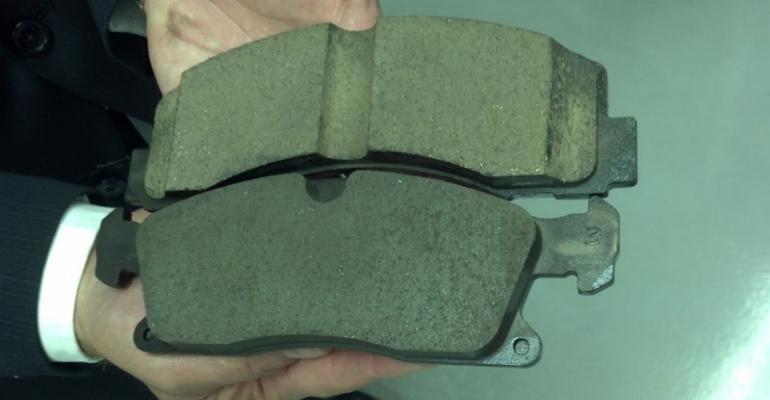PLYMOUTH, MI – The brake-pad segment will undergo a massive transformation in the next decade as two Pacific Coast states have adopted legislation drastically limiting the amount of copper in brake pads in an attempt to prevent harmful impact on salmon.
Brake pads today contain about 15% copper; every time brakes are applied, a small amount of copper scrubs off the pads and lands on pavement, eventually washing off during rainstorms and finding its way to rivers, streams and coastal waters.
Phytoplankton eat the copper dust, and salmon feed heavily on the plankton. As a result, researchers say copper upsets a salmon’s sense of smell, making it vulnerable to predators and unable to find its way to spawning streams.
Although copper is used extensively for electrical wiring and in many other sectors of the economy, the legislation affects only the auto industry because copper in storm water runoff has been tied directly to vehicles.
With millions of vehicles on the road in California and Washington and healthy salmon fisheries crucial to the economy and ecology of both areas, the two states contend the problem is serious enough to warrant legislation, which phases in beginning in 2021.
Although limited to two states, auto makers and brake suppliers will not make unique products for California and Washington, which means the entire U.S. market likely will have copper-free brake pads by 2025, says Stefan Anger, director-application engineering, friction at Federal-Mogul, the world’s largest supplier of aftermarket brake pads and No.2 producer of original-equipment pads.
With global vehicle architectures taking root, Anger says it is likely the legislation in two U.S. states eventually will result in copper-free brake pads in the largest, mature markets of Western Europe, Japan and China.
“Ford, GM and Chrysler specify that they want low-copper now” for next-generation vehicles, Anger says. “As European car companies want to sell cars here as well, they have to adhere to it. They’re marching in the same direction.”
Federal-Mogul has a contract to supply low-copper pads for a high-volume passenger car beginning in 2014, Anger says. The supplier also has several development programs with other auto makers.
The global implications of protecting salmon in California and Washington could be immense: In 2011, the auto industry produced 78.4 million vehicles worldwide. Each vehicle has two brake pads per wheel, which means the industry supplied 627 million brake pads last year, excluding the hundreds of millions manufactured for the aftermarket.
Copper is one of up to 30 materials used to formulate non-asbestos organic brake pads, also known as ceramic pads, used predominantly in the U.S. Asbestos stoppers were phased out more than a decade ago.
Fullsize pickups generally use semi-metallic iron-intensive pads, which already are copper-free, but those pads present certain noise, vibration and harshness challenges in cars, Anger says.
So brake producers are reformulating their pads for cars to meet the new legislation, which limits copper content to 5% in 2021 and 0.5% in 2025. The legislation applies to both disc and drum brakes.
“Federal-Mogul’s approach is to get to zero-copper,” Anger says. “We take it all out.”
The supplier replaces copper with metal sulfides, resins, abrasives, fibers, ceramic particles and types of graphite, but asking for more specifics is like asking Coca-Cola for the recipe of its soft drink. Each brake-pad manufacturer uses a slightly different formulation, designed to maximize wear life and driving comfort and minimize fade, judder and noise.
“Copper plays a vital role in the friction material, itself, because of its stability,” Anger says. “If you just take the copper out, the brake pad will not function. You have to replace it with materials of similar characteristics.”
He calls the project to replace copper “a technological challenge, which we mastered. We developed a methodology allowing us to replace one friction material relatively quickly by testing its friction behavior.”
In the process, Federal-Mogul screened some 1,500 raw materials to find the right combination for replacement. Many of the materials have been validated or weeded out by testing them on five dynamometers at the Federal-Mogul tech center here.
The supplier manufactures brake pads at 15 plants around the world, including several in the U.S.
Anger describes copper as one of the more expensive materials used in brake pads. “It’s definitely not a filler,” he says.
With its lubricating qualities, copper is necessary to establish the friction film, known as the transfer layer, that forms on the surface of the pad as the brakes are applied and as they heat up, Anger says. Copper also conducts heat well, which prolongs wear, improves friction levels and helps the transfer layer maintain temperature stability.
From a consumer standpoint, the switch to low-copper pads will be unnoticeable because Anger is confident the friction characteristics will be the same as conventional brakes. But he says drivers may notice slightly improved performance and better static friction behavior, which is beneficial for parking in hilly areas.
The switch also should be transparent to auto makers because brake systems will not need to be redesigned to accommodate the new friction materials.
Anger says it’s too early to discuss pricing of low-copper brake pads, but adds they likely will not be less expensive.



